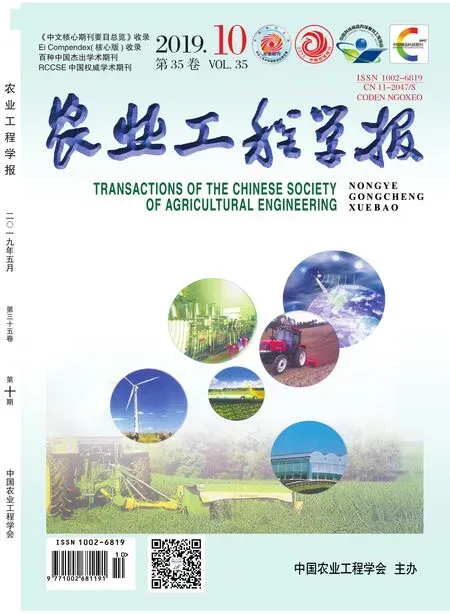基于四方对称光源透射光谱的脐橙可溶性固形物检测
宋 杰,李光林,杨晓东,张 信,刘旭文
基于四方对称光源透射光谱的脐橙可溶性固形物检测
宋 杰,李光林※,杨晓东,张 信,刘旭文
(西南大学工程技术学院,重庆 400715)
提高利用可见-近红外(Vis-NIR)透射光谱检测脐橙内部物质含量的准确性在生产实际中具有重要意义。该研究利用特制的可见-近红外透射光谱测量装置采集了199个福本脐橙果蒂向上、水平、向下3种位置的透射光谱,比较了多元散射校正(multivariate scattering correction, MSC)、标准正态变量变换(standard normal variate transformation, SNV)、一阶导数和二阶导数预处理的效果,并采用效果最好的一阶导数对透射光谱进行预处理。在此基础上,结合后向区间偏最小二乘法(backward interval partial least squares, BiPLS)优选特征波段,竞争性自适应重加权采样(competitive adaptive re-weighted sampling, CARS)挑选特征变量建立了基于果蒂向上、水平、向下3种位置各自的透射光谱以及3种位置的平均光谱和加权光谱的可溶性固形物(soluble solid content, SSC)的偏最小二乘(partial least squares, PLS)模型。在果蒂向上、水平、向下3种位置各自的透射光谱建立的PLS模型中,基于果蒂水平位置透射光谱的PLS模型最优,校正相关系数为0.914,校正均方根误差为0.380,预测相关系数为0.924,预测均方根误差为0.404。基于果蒂向上、水平、向下3种位置平均透射光谱和加权透射光谱建立的PLS模型均取得了较好的预测结果,预测相关系数均大于0.91,预测均方根误差均小于0.43。该研究可以为脐橙内部物质含量在线检测装备的研制提供参考。
果实;光谱分析;模型;脐橙;四方对称光源;透射;可溶性固形物
0 引 言
脐橙是一种营养丰富、经济价值较高的水果,在中国有广泛的种植面积。随着生活水平的提高,人们在购买水果时不仅仅局限于对外观品质的要求,而是更加关注其内部品质[1-2]。因此渠道商越来越注重脐橙的产后分级处理,提高脐橙的商品化价值。
可见-近红外光谱(Vis-NIR)技术是一种快速、非破坏性检测技术,已广泛应用于水果内部品质的无损检 测[3-5],如苹果[6-9]、桃子[10-11]、西瓜[12-13]、梨[14-15]等。可溶性固形物(soluble solid content, SSC)是水果内部品质评价的主要指标之一。在利用Vis-NIR技术实现脐橙SSC检测的研究中,Jamshidi等[16]和Ncama等[17]采用反射测量方式沿脐橙赤道部位采集多点光谱求平均建立PLS模型对脐橙SSC进行检测。由于反射测量中光的穿透深度有限,而可溶性固形物在脐橙中沿横径和纵径分布都不均匀[18],因此利用反射测量方式获取的光谱信息不能承载脐橙果实内部的SSC信息。
近年来部分研究人员利用透射测量方式获取脐橙果实内部的光谱信息进行分析。刘燕德等[19-20]利用水果分级传送带,通过人工上果将脐橙放置在果托上,果蒂与果脐连线方向与传送带运动方向一致,采集赤道部位的光谱对脐橙SSC进行动态检测。由于果皮对光的衰减作用较强[21-22],并且果皮在果脐、赤道、果蒂部位的厚度不均匀,导致利用透射测量方式获取脐橙内部物质含量的光谱信息时会受到光源布置和脐橙放置位置的影响。许文丽等[23]使用了2个卤钨灯水平布置于样品两侧,实现半透射检测,研究了果蒂与果脐连线与入射光线平行、垂直和任意角度时对近红外光谱检测结果的影响。然而,由于脐橙形状大小不一致,并且果皮厚度不均匀,仅通过两侧光源进行辐射时还存在一定的测量误差。为了获取脐橙内部更全面的透射光谱信息,进一步降低测量误差,本文通过自己设计的光源系统将4个卤钨灯对称布置于样品四周,光源中心轴线与信号探头竖直中心轴线所成角度为40°,且光源中心轴线的交点为样品下部,通过样品下部接收透射信号。比较研究了基于果蒂向上、水平、向下3种位置透射光谱的PLS模型对脐橙SSC进行预测的效果。在此基础上,研究了利用3种位置平均光谱和加权光谱建模对脐橙SSC进行预测的效果,以期为脐橙内部物质含量在线检测装备的研制奠定更多的基础。
1 材料与方法
1.1 脐橙样品
于2017年12月20日在重庆巫山(经度:109.86,纬度:31.10)采摘了199个福本脐橙样品进行试验。样品运输至实验室之后,剪掉枝叶,保留果蒂,每个脐橙均编号并装入厚度为0.02 mm的聚乙烯袋,保存于温度为4 ℃,相对湿度为60%的储藏室中,保存时间不超过 3 d。在进行试验前将样品放置于室温环境(14±2)℃ 24 h。
1.2 脐橙透射光谱测量
脐橙的透射光谱是通过我们自己设计的光谱测量系统采集的,测量系统包括一个580 mm × 600 mm × 610 mm的箱体用于隔离系统外部的光,箱体固定,并在底部设置有防震垫。箱体内部设置有隔离板,防止光源对信号接收探头造成干扰,隔离板中间设置有一个带通孔的果托(孔径为44 mm)。光源包括4个24 V/100 W的卤钨灯泡(OSRAM, 64460U, 3 000 K, Germany),对称设置在果托上方。通过试验测试,确定光源中心轴线与信号探头竖直中心轴线所成角度为40°,灯泡中心与待测脐橙中心的水平距离为100 mm,垂直距离为80 mm时,获取的透射信号最强。为了达到更好的聚光效果,使用了发散角为10°的灯杯。为了便于散热,灯头处连接了一个直径为110 mm,厚度为10 mm的环形散热器(60齿结构),连接处填充了导热硅脂。2个风扇(Sanyo GV1224P1H03, Japan)正对设置在箱体左右两侧,与散热器位置匹配,一个用于吸入箱体外的冷空气,另一个用于排出箱体内的热空气。电源(WEHO, SCN-800-24, China)、光谱仪(Ocean Optics, QEpro, USA,响应范围400~980 nm)、信号接收探头(视场角约43°)设置在隔离板下面,与光源完全隔离。使用了一台安装有光谱采集软件(OceanView1.6.3)的计算机(Lenovo, IdeaPad 710S, China)采集光谱数据。脐橙透射光谱测量系统原理图如图1所示。
光谱仪的积分时间设置为50 ms,在采集透射光谱前保存了参考光谱和暗光谱,则透过率可表示为
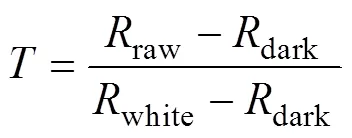
根据下式将透过率转化为吸光度:

式中为吸光度。
分别采集了脐橙3个位置的透射光谱,包括果蒂向上(P1)、果蒂水平(P2)、果蒂向下(P3)。在每个位置沿水平方向旋转脐橙,每间隔120°采集一次光谱,共采集3次取平均,如图2所示。
图2中可以看到几个明显的特征吸收峰,出现在680 nm附近的峰是由于色素吸收所致[24],760 nm附近的吸收峰是OH键伸缩振动和水的吸收的四倍频[25],970 nm附近的吸收峰是OH键伸缩振动和水的吸收的三倍频[26]。图2c中存在几条光谱与正常光谱发生偏离,这几个样品属于畸形果,果形不正,为了防止漏光,在摆放该脐橙测量果蒂向下位置的透射光谱时,果蒂并不是朝向正下方,而是有些偏离,导致了这几个样品在该位置的透过率偏高,从而导致光谱曲线发生偏离。考虑到实际应用中存在畸形果对测量的影响,为了保证模型的适应能力,我们在建模时并未将这些偏离的光谱数据进行剔除。
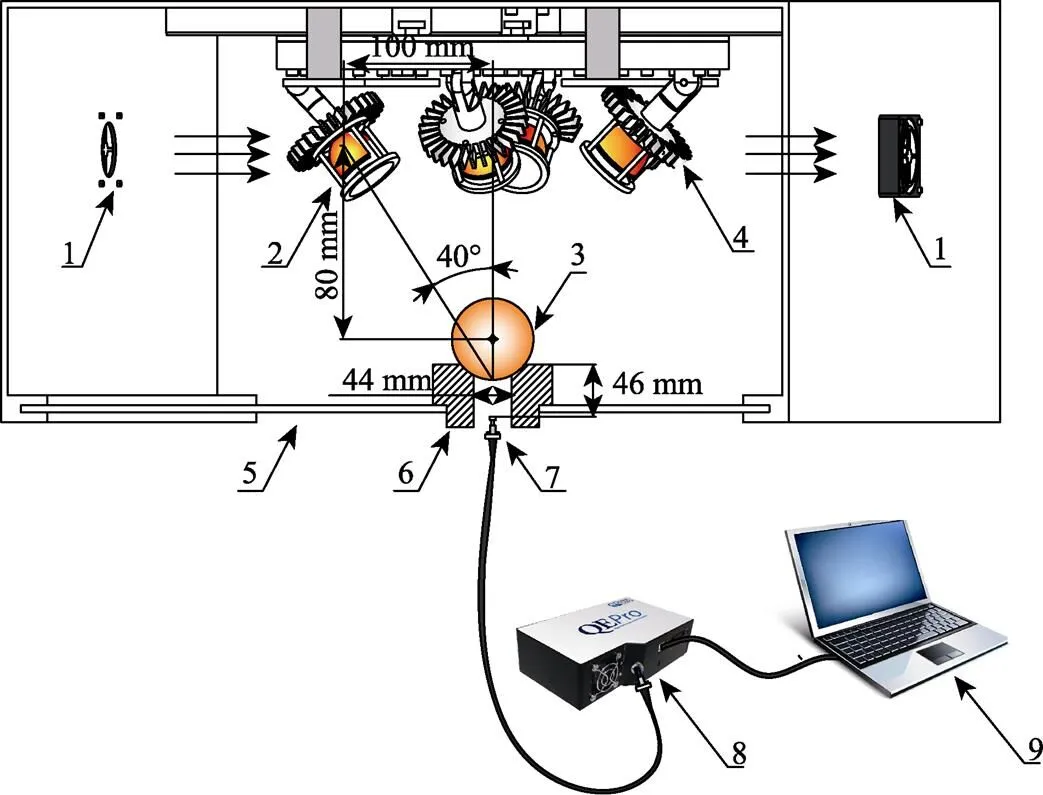
1. 风扇 2. 光源 3. 脐橙 4. 散热器 5. 隔板 6. 果托 7. 探头 8. 光谱仪 9. 计算机
1.3 样品理化参数测量
采集完光谱后,测量了样品的理化参数。通过游标卡尺测量了样品的横径和纵径,以及样品在果脐部位、赤道部位和果蒂部位的皮厚。之后用榨汁机(KESUN, KP60SC, China)将样品和皮一同榨成汁。将汁液过滤后利用数字折射计(ATAGO, RX-5000i-Plus, Japan)测量了样品的SSC含量。理化参数统计结果如表1所示。
表1中脐橙样品的横径平均值和纵径平均值相差不大,表明该品种脐橙果形为类球形。从脐橙不同部位皮厚统计结果可以看出,果蒂部位的皮最厚。
1.4 算法原理
1.4.1 后向区间偏最小二乘法

1.4.2 竞争性自适应重加权算法
竞争性自适应重加权算法(competitive adaptive re-weighted sampling, CARS)的采样过程类似于达尔文进化论中的“适者生存”原则,它是以一种有效和竞争的方式实现的[29]。假设蒙特卡罗采样次数为,然后CARS依次从次蒙特卡罗采样中以迭代和竞争的方式选择个波长子集。在CARS中,PLS模型的回归系数的绝对值被用来作为评估每个变量重要性的指标。在每次采样中,以固定比例随机选择样本建立校正模型,然后采用指数递减函数和自适应重加权算法根据回归系数选择关键波长,最后通过PLS交叉验证来评估所选择的数据集[30]。
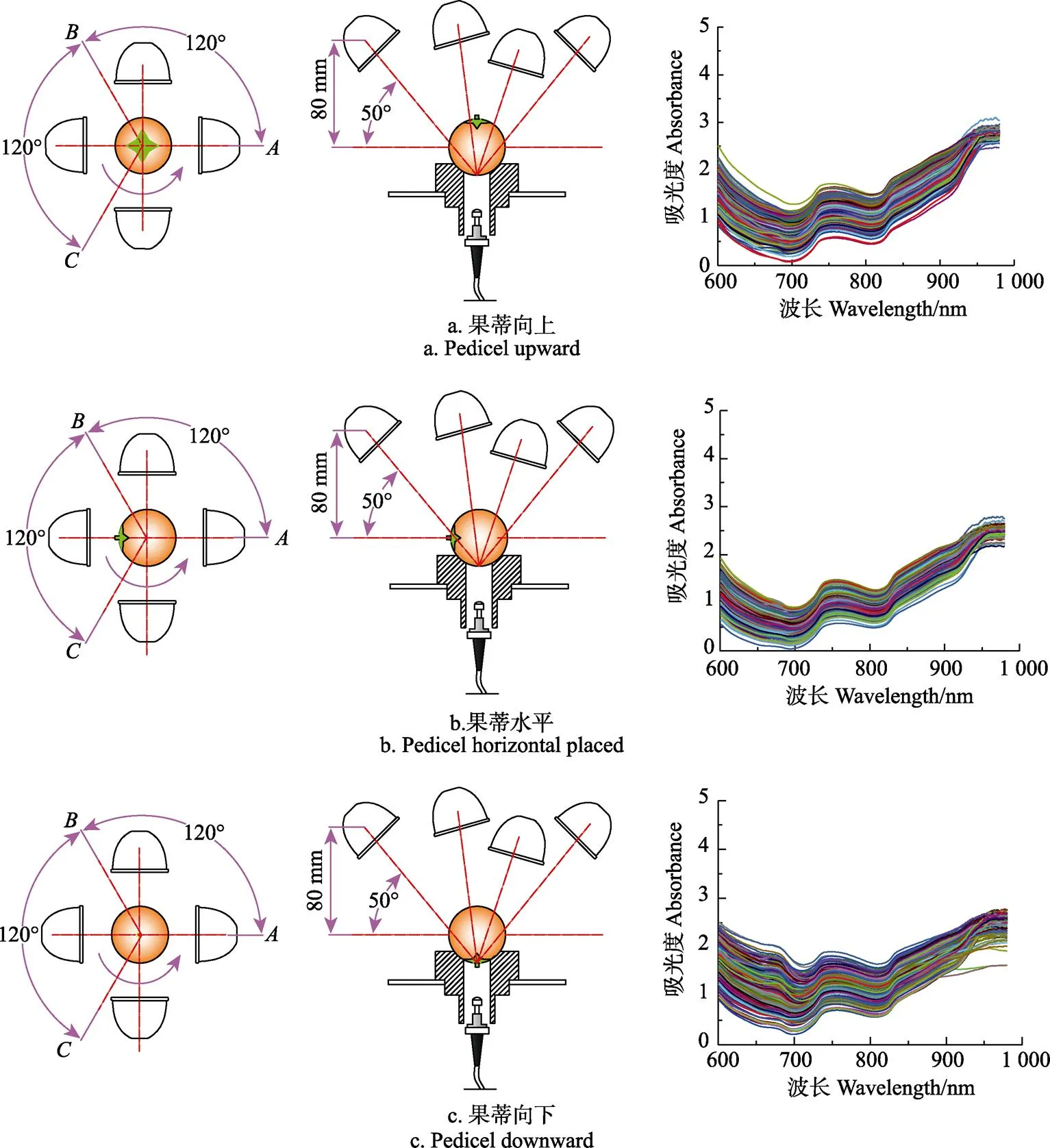
注:图2a、2b、2c中从左至右依次为光谱采集位置俯视图、光谱采集位置正视图、该位置的平均透射光谱,图中A、B、C为脐橙每旋转120°所对应的位置。
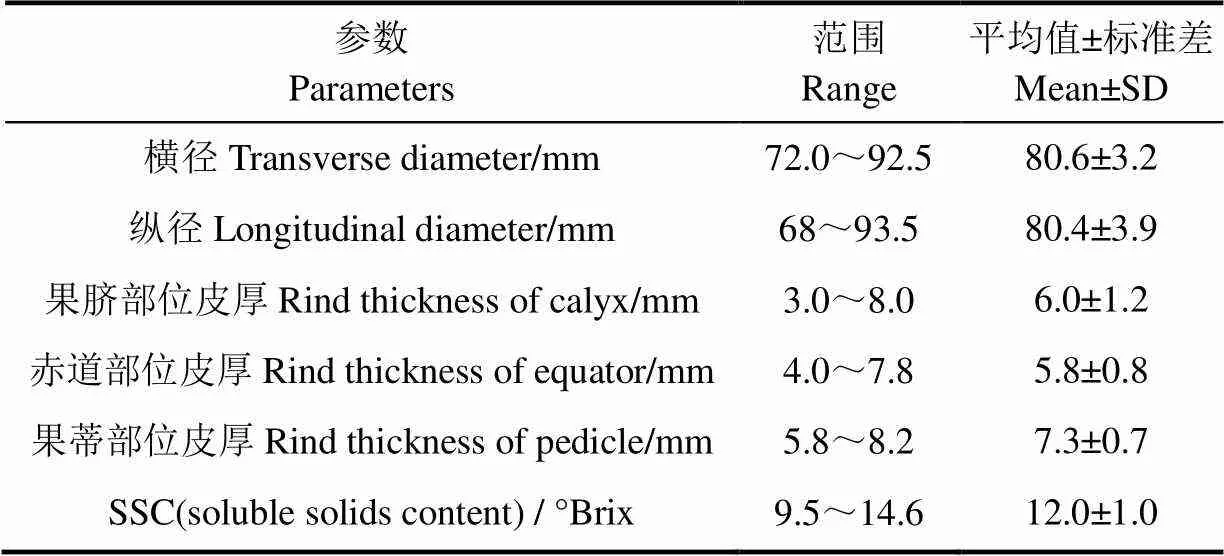
表1 福本脐橙理化参数统计结果
2 结果与分析
利用软件The Unscrambler X 10.4,采用outlier方法剔除了一个异常样品,并将剩余样品随机划分为校正集(150个)和预测集(48个)。分别采用SNV、MSC、一阶导数和二阶导数对脐橙透射光谱进行预处理,并通过PLS交叉验证来评估预处理效果,如表2所示。
表2中,P1、P2、P3的加权系数是根据P1、P2、P3光谱的交叉验证结果,采用贡献率的思路来确定的。P2光谱的交叉验证结果明显优于P1和P3,则进行加权时权重应最大,P3光谱的交叉验证结果最差,则进行加权时权重应最小。分别以0.05为取值间隔进行试验,并比较PLS交叉验证结果,最终确定最佳系数为0.15、0.8和0.05。从表2可以看出,采用SNV、MSC、一阶导数和二阶导数对P1、P2、P3位置的光谱及三者的平均光谱和加权光谱进行预处理时,均是一阶导数效果最佳,但由于不同位置采集的透射光谱的吸光度和信噪比有差异,因此进行预处理时通过调整窗口数来获得最佳预处理结果。4种预处理方法中,采用SNV和MSC预处理的结果相差不大,这与文献报道的结论一致[31]。采用二阶导数预处理后PLS模型的因子数少于一阶导数预处理后的PLS模型,但是交叉验证结果比一阶导数预处理略差。P1、P2、P3位置的光谱及三者的平均光谱和加权光谱经一阶导数预处理后建立的PLS模型中,基于P1、P2和P3位置加权光谱的PLS模型最优。将上述经一阶导数预处理后的光谱数据用于后续分析,为便于表示,记(P1+P2+P3)/3为P4,(0.15P1+0.8P2+0.05P3)为P5,采用BiPLS优选特征波段,将P1、P2、P3、P4、P5的光谱数据分别分为30~50段(间隔为5段),并基于PLS模型的RMSECV评估分段效果。当分段数分别为35、40、30、35、40时效果最佳,统计结果如表3所示。
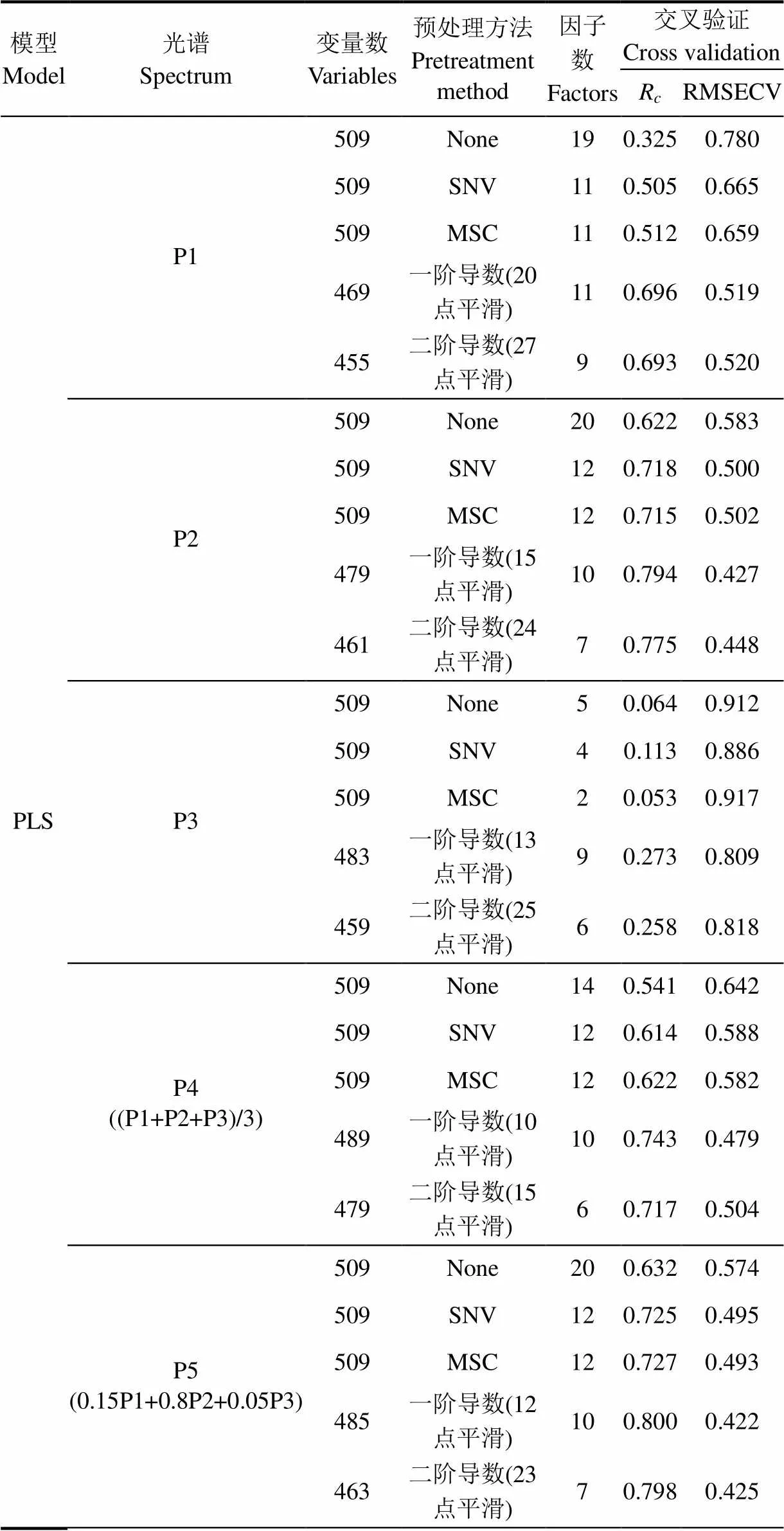
表2 基于不同预处理方法的PLS交叉验证结果
注:表2中P1、P2、P3分别代表脐橙果蒂向上、果蒂水平、果蒂向下位置获取的透射光谱,(P1+P2+P3)/3代表P1、P2、P3的平均光谱,0.15P1+0.8P2+0.05P3代表P1、P2、P3的加权光谱。
Note: P1, P2 and P3 represent the transmission spectra of navel orange pedicle upward, pedicle horizontal placed and pedicle downward respectively; (P1+P2+P3)/3 represents the average spectra of P1, P2 and P3; 0.15P1+0.8P2+0.05P3 represents the weighted spectra of P1, P2 and P3.

表3 基于BiPLS的特征波段优选结果
从表3中可以看出,基于P5光谱的波段优选效果最佳,保留的变量数为170,RMSECV为0.390。基于P2光谱的波段优选效果与基于P5光谱的结果很接近,保留的变量数为180,RMSECV为0.393。基于P4光谱的波段优选效果次之,RMSECV为0.458,但保留的变量数为308,数量较多。基于P3光谱的波段优选效果最差,保留的变量数为114,RMSECV为0.837,这可能是由于果蒂部位的皮较厚(见表1),且果蒂的存在对光的穿透形成了较大障碍,使得透射光谱的信噪比较低所致。
在对P1、P2、P3、P4、P5光谱优选波段的基础上,分别利用CARS算法挑选特征变量并建立PLS模型,其中CARS运行次数均为20次,统计最优结果如表4所示:
表4中,基于P5光谱建立的PLS模型最优,校正相关系数为0.914,校正均方根误差为0.382,预测相关系数为0.928,预测均方根误差为0.383。但该模型是通过果蒂向上、水平、向下3个位置加权透射光谱建立的,生产中需利用特殊装置进行定位,在线检测较难实现。基于P4光谱建立的PLS模型也取得了较好的预测结果,预测相关系数为0.911,预测均方根误差为0.420。该模型只利用了果蒂向上、果蒂水平和果蒂向下3个位置光谱的平均光谱建模,而实际应用时可以通过翻滚样品获取多次光谱的平均光谱建模,这在生产中是容易实现的。在P1、P2、P3位置各自透射光谱建立的PLS模型中,基于P2位置光谱建立的PLS模型最优,校正相关系数为0.914,校正均方根误差为0.380,预测相关系数为0.924,预测均方根误差为0.404。若在线检测时自定心装置能将脐橙位置调整为果蒂水平,则检测效果较好,但部分脐橙样品的横径与纵径相差不大(见表1),果形为类球形,目前生产应用中的自定心装置还无法自动将脐橙果蒂全部调整为水平位置,因此无法达到预期效果,存在在线检测部位与建模时采集光谱部位不一致的情况,影响检测准确性。基于P3位置光谱建立的PLS模型效果最差,校正相关系数为0.546,校正均方根误差为0.794,预测相关系数为0.586,预测均方根误差为0.799。该模型是通过果蒂向下位置透射光谱建立的,在本研究中采用的光源布置下,果蒂向下时果蒂与信号接收探头正对,极大阻碍了光的穿透,因此该位置获得的信号的信噪比较低,是影响脐橙SSC检测准确性的主要原因。

表4 基于CARS的PLS建模及预测结果
3 结 论
为了提高利用Vis-NIR透射光谱在线检测脐橙内部物质含量的准确性,该文利用特制的可见-近红外透射光谱测量装置采集了福本脐橙果蒂向上、水平、向下3个位置的透射光谱进行试验研究。
1)在果蒂向上、水平、向下3个位置各自透射光谱建立的PLS模型中,基于果蒂水平放置时的透射光谱建立的PLS模型最优,校正相关系数为0.914,校正均方根误差为0.380,预测相关系数为0.924,预测均方根误差为0.404。
2)基于果蒂向上、水平、向下3个位置平均透射光谱和加权透射光谱建立的PLS模型均取得了较好的预测结果,预测相关系数均大于0.91,预测均方根误差均小于0.43。
今后将进一步改进和优化试验装置,提高脐橙SSC在线检测的准确性。
[1] Magwaza L S, Opara U L, Nieuwoudt H, et al. NIR spectroscopy applications for internal and external quality analysis of citrus fruit: A review[J]. Food and Bioprocess Technology, 2012, 5: 425-444.
[2] Xie L J, Wang A C, Xu H R, et al. Applications of near-infrared systems for quality evaluation of fruits: A-review[J]. Transactions of the ASABE, 2016, 59(2): 399-419.
[3] Nicolai B M, Defraeye T, Ketelaere B D, et al. Nondestructive measurement of fruit and vegetable quality[J]. Annual Review of Food Science and Technology, 2014, 5: 285-312.
[4] Magwaza L S, Opara U L, Nieuwoudt H, et al. NIR spectroscopy applications for internal and external quality analysis of citrus fruit-A review [J]. Food and Bioprocess Technology, 2012, 5: 425-444.
[5] Wang H L, Peng J Y, Xie C Q, et al. Fruit quality evaluation using spectroscopy technology: A review [J]. Sensors, 2015, 15: 11889-11927.
[6] Yuan L M, Cai J R, Sun L, et al. Nondestructive measurement of soluble solids content in apples by a portable fruit analyzer [J]. Food Analytical Methods, 2016, 9: 785-794.
[7] Fan S X, Guo Z M, Zhang B H, et al. Using Vis/NIR diffuse transmittance spectroscopy and multivariate analysis to predicate soluble solids content of apple [J]. Food Analytical Methods, 2016, 9: 1333-1343.
[8] Luo X, Ye Z Z, Xu H R, et al. Robustness improvement of NIR-based determination of soluble solids in apple fruit by local calibration [J]. Postharvest Biology and Technology, 2018, 139: 82-90.
[9] 李龙,彭彦昆,李永玉,等. 苹果内外品质在线无损检测分级系统设计与试验[J]. 农业工程学报, 2018, 34(9): 267-275. Li Long, Peng Yankun, Li Yongyu, et al. Design and experiment on grading system for online non-destructive detection of internal and external quality of apple[J]. Transactions of the Chinese Society of Agricultural Engineering (Transactions of the CSAE), 2018, 34(9): 267-275. (in Chinese with English abstract)
[10] 刘燕德,吴明明,孙旭东,等. 黄桃表面缺陷和可溶性固形物光谱同时在线检测[J]. 农业工程学报, 2016, 32(6): 289-295. Liu Yande, Wu Mingming, Sun Xudong, et al. Simultaneous detection of surface deficiency and soluble solids content for amygdalus persica by online visible-near infrared transmittance spectroscopy[J]. Transactions of the Chinese Society of Agricultural Engineering (Transactions of the CSAE), 2016, 32(6): 289-295. (in Chinese with English abstract)
[11] Nascimento P M, Carvalho L C, Junior L C, et al. Robust PLS models for soluble solids content and firmness determination in low chilling peach using near-infrared spectroscopy (NIR) [J]. Postharvest Biology and Technology, 2016, 111: 345-351.
[12] 介邓飞,陈猛,谢丽娟,等. 适宜西瓜检测部位提高近红外光谱糖度预测模型精度[J]. 农业工程学报,2014, 30(9): 229-234. Jie Dengfei, Chen Meng, Xie Lijuan, et al. Improving precision of soluble solid content predictive model by adopting suitable detective position of watermelon based on near infrared spectroscopy[J]. Transactions of the Chinese Society of Agricultural Engineering (Transactions of the CSAE), 2014, 30(9): 229-234. (in Chinese with English abstract)
[13] 钱曼,黄文倩,王庆艳,等. 西瓜检测部位差异对近红外光谱可溶性固形物预测模型的影响[J]. 光谱学与光谱分析, 2016, 36(6): 1700-1705. Qian Man, Huang Wenqian, Wang Qingyan, et al. Assessment of influence detective position variability on precision of near infrared models for soluble solid content of watermelon [J]. Spectroscopy and Spectral Analysis, 2016, 36(6): 1700-1705. (in Chinese with English abstract)
[14] 樊书祥,黄文倩,李江波,等. LS-SVM 的梨可溶性固形物近红外光谱检测的特征波长筛选[J]. 光谱学与光谱分析,2014, 34(8): 2089-2093. Fan Shuxiang, Huang Wenqian, Li Jiangbo, et al. Characteristic wavelengths selection of soluble solids content of pear based on NIR spectral and LS-SVM[J]. Spectroscopy and Spectral Analysis, 2014, 34(8): 2089-2093. (in Chinese with English abstract)
[15] Sun X D, Liu Y D, Li Y F, et al. Simultaneous measurement of brown core and soluble solids content in pear by on-line visible and near infrared spectroscopy [J]. Postharvest Biology and Technology, 2016, 116: 80-87.
[16] Jamshidi B, Minaei S, Mohajerani E, et al. Reflectance Vis/NIR spectroscopy for nondestructive taste characterization of[J]. Computers and Electronics in Agriculture, 2012, 85: 64-69.
[17] Ncama K, Opara U L, Tesfay S Z, et al. Application of Vis/NIR spectroscopy for predicting sweetness and flavour parameters of() and() [J]. Journal of Food Engineering, 2017, 193: 86-94.
[18] Peiris K, Kays S. Spatial variability of soluble solids or dry-matter content within individual fruits, bulbs, or tubers implications for the development and use of NIR spectrometric techniques [J]. HortScience, 1999, 34(1): 114-117.
[19] 刘燕德,施宇,蔡丽君,等. 基于CARS算法的脐橙可溶性固形物近红外在线检测[J]. 农业机械学报, 2013, 44(9): 138-144. Liu Yande, Shi Yu, Cai Lijun, et al. On-line NIR detection model optimization of soluble solids content in navel orange based on CARS [J]. Transactions of Chinese Society for Agricultural Machinery, 2013, 44(9): 138-144. (in Chinese with English abstract)
[20] 刘燕德,胡军,欧阳玉平,等. 赣南脐橙可溶性固形物近红外光谱在线无损检测[J]. 广东农业科学, 2016, 43(9): 105-111. Liu Yande, Hu Jun, Ouyang Yuping, et al. Online detection of soluble solids content forby visible-near infrared diffuse transmission spectroscopy[J]. Guangdong Agricultural Sciences, 2016, 43(9): 105-111. (in Chinese with English abstract)
[21] Fraser D G, Jordan R B, Kunnemeyer R, et al. Light distribution inside mandarin fruit during internal quality assessment by NIR spectroscopy [J]. Postharvest Biology and Technology, 2003, 27: 185-196.
[22] 孙通,莫欣欣,刘木华. 果皮对脐橙可溶性固形物可见/近红外检测精度的影响[J]. 光谱学与光谱分析, 2018, 38(5): 1406-1411. Sun Tong, Mo Xinxin, Liu Muhua. Effect of pericarp on prediction accuracy of soluble solid content in navel oranges by visible/near infrared spectroscopy[J]. Spectroscopy and Spectral Analysis, 2018, 38(5): 1406-1411. (in Chinese with English abstract)
[23] 许文丽,孙通,吴文强,等. 脐橙放置位置对近红外光谱检测结果的影响[J]. 光谱学与光谱分析, 2012, 32(11): 3002-3005. Xu Wenli, Sun Tong, Wu Wenqiang, et al. Near-infrared spectrum detection result influenced by navel oranges placement position [J]. Spectroscopy and Spectral Analysis, 2012, 32(11): 3002-3005. (in Chinese with English abstract)
[24] Gomez A H, He Y, Pereira A G. Non-destructive measurement of acidity, soluble solids and firmness ofusing Vis/NIR spectroscopy techniques [J]. Journal of Food Engineering, 2006, 77: 313-319.
[25] Golic M, Walsh K, Lawson P. Short-wavelength near-infrared spectra of sucrose, glucose, and fructose with respect to sugar concentration and temperature [J]. Applied Spectroscopy, 2003, 57: 139-145.
[26] Magwaza L S, Opara U L, Terry L A, et al. Evaluation of fourier transform-NIR spectroscopy for integrated external and internal quality assessment of[J]. Journal of Food Composition and Analysis, 2013, 31: 144-154.
[27] Leardi R, Norgaard L. Sequential application of backward interval partial least squares and genetic of relevant spectral regions [J]. Journal of Chemometrics, 2004, 18: 486-497.
[28] Zhou X B, Zhao J W, Li Y X. Selection of the efficient wavelength regions in FT-NIR spectroscopy for determination of SSC ofbased on BiPLS and FiPLS models [J]. Vibrational Spectroscopy, 2007, 44: 220-227.
[29] Fan S X, Zhang B H, Li J B, et al. Effect of spectrum measurement position variation on the robustness of NIR spectroscopy models for soluble solids content of apple [J]. Biosystems Engineering, 2016, 143: 9-19.
[30] Li H D, Liang Y Z, Xu Q S, et al. Key wavelengths screening using competitive adaptive reweighted sampling method for multivariate calibration [J]. Analytica Chimica Acta, 2009, 648: 77-84.
[31] Dhanoa M S, Lister S J, Sanderson R, et al. The link between multiplicative scatter correction (MSC) and standard normal variate (SNV) transformations of NIR spectra [J]. Journal of Near Infrared Spectroscopy, 1994, 2: 43-47.
Detecting soluble solids content of navel orange based on transmission spectrum of tetragonal symmetric light source
Song Jie, Li Guanglin※, Yang Xiaodong, Zhang Xin, Liu Xuwen
(,,400715,)
Navel orange is a very popular fruit in China, which is mainly cultivated along the Yangtze River. Navel oranges are classified into different grades based on external quality and internal quality before they are sold. Soluble solids content is one of the main indices for evaluating the internal quality of navel orange. Therefore, it is very important to improve the detection accuracy of soluble solids content in production. So far, visible and near infrared spectroscopy (Vis-NIR) is one of the most widely used and effective techniques in internal quality assessment of fruits. In this study, 199 Fukumoto navel oranges were taken as experimental samples. The transmission spectra of navel oranges of three positions including pedicle upwards (P1), pedicle horizontal (P2) and pedicle downward (P3) were acquired by using a special visible and near infrared transmission spectrum measurement system designed by ourselves. The average spectra (P4) and weighted spectra (P5) of P1, P2 and P3 were calculated. The transmission spectra, including P1, P2, P3, P4 and P5 were preprocessed by multivariate scattering correction, standard normal variate transformation, first derivative and second derivative respectively. The best pretreatment results were obtained based on first derivative after comparative study. Then the spectra data preprocessed by first derivative were divided into 30 to 50 intervals with step length of 5, and backward interval partial least squares was used to select the optimal band combination. Good results observed when P1, P2, P3, P4 and P5 were divided into 35, 40, 30, 35 and 40 intervals, in which 161, 180, 114, 308 and 170 variables were retained. On this basis, competitive adaptive re-weighted sampling (CARS) was used to select feature variables. After running CARS for 20 times in each selection, 24, 23, 18, 39 and 22 variables were kept respectively. Finally, Five PLS models were established, including P1-PLS, P2-PLS, P3-PLS, P4-PLS and P5-PLS. Among the P1-PLS, P2-PLS and P3-PLS models, P2-PLS model was the best one, as the value of correlation coefficients of prediction was 0.924 and the value of root mean square error of predictionwas 0.404. This model can be realized by adjusting the navel oranges to pedicle horizontal in modeling. P4-PLS model and P5-PLS model had achieved good prediction results, as the value of correlation coefficients of prediction was higher than 0.91 and the value of root mean square error of prediction was lower than 0.43. P4-PLS model was based on the average spectra of P1, P2 and P3, and had potential to be realized by rolling the navel oranges in actual application. However, P5-PLS model was based on weighted spectra of P1, P2 and P3, which was difficult to realize in on-line detection. This study can provide a reference for the development of on-line detection equipment for the assessment of internal content of substances in navel orange.
fruit; spectrum analysis; models; navel orange; tetragonal symmetric light source; transmittance; soluble solids content
10.11975/j.issn.1002-6819.2019.10.034
S233.5; O657.33
A
1002-6819(2019)-10-0267-07
2018-12-27
2019-04-13
重庆市科委重点项目(cstc2018jszx-cyzdx0051)、中央高校基本科研业务费重点项目(XDJK2016B026)
宋 杰,讲师,博士生,主要从事智能控制与检测技术研究。Email:sj2008@swu.edu.cn
李光林,教授,博士生导师,主要从事传感器与智能检测技术研究。Email:liguanglin@swu.edu.cn
宋 杰,李光林,杨晓东,张 信,刘旭文. 基于四方对称光源透射光谱的脐橙可溶性固形物检测[J]. 农业工程学报,2019,35(10):267-273. doi:10.11975/j.issn.1002-6819.2019.10.034 http://www.tcsae.org
Song Jie, Li Guanglin, Yang Xiaodong, Zhang Xin, Liu Xuwen.Detecting soluble solids content of navel orange based on transmission spectrum of tetragonal symmetric light source[J]. Transactions of the Chinese Society of Agricultural Engineering (Transactions of the CSAE), 2019, 35(10): 267-273. (in Chinese with English abstract) doi:10.11975/j.issn.1002-6819.2019.10.034 http://www.tcsae.org

